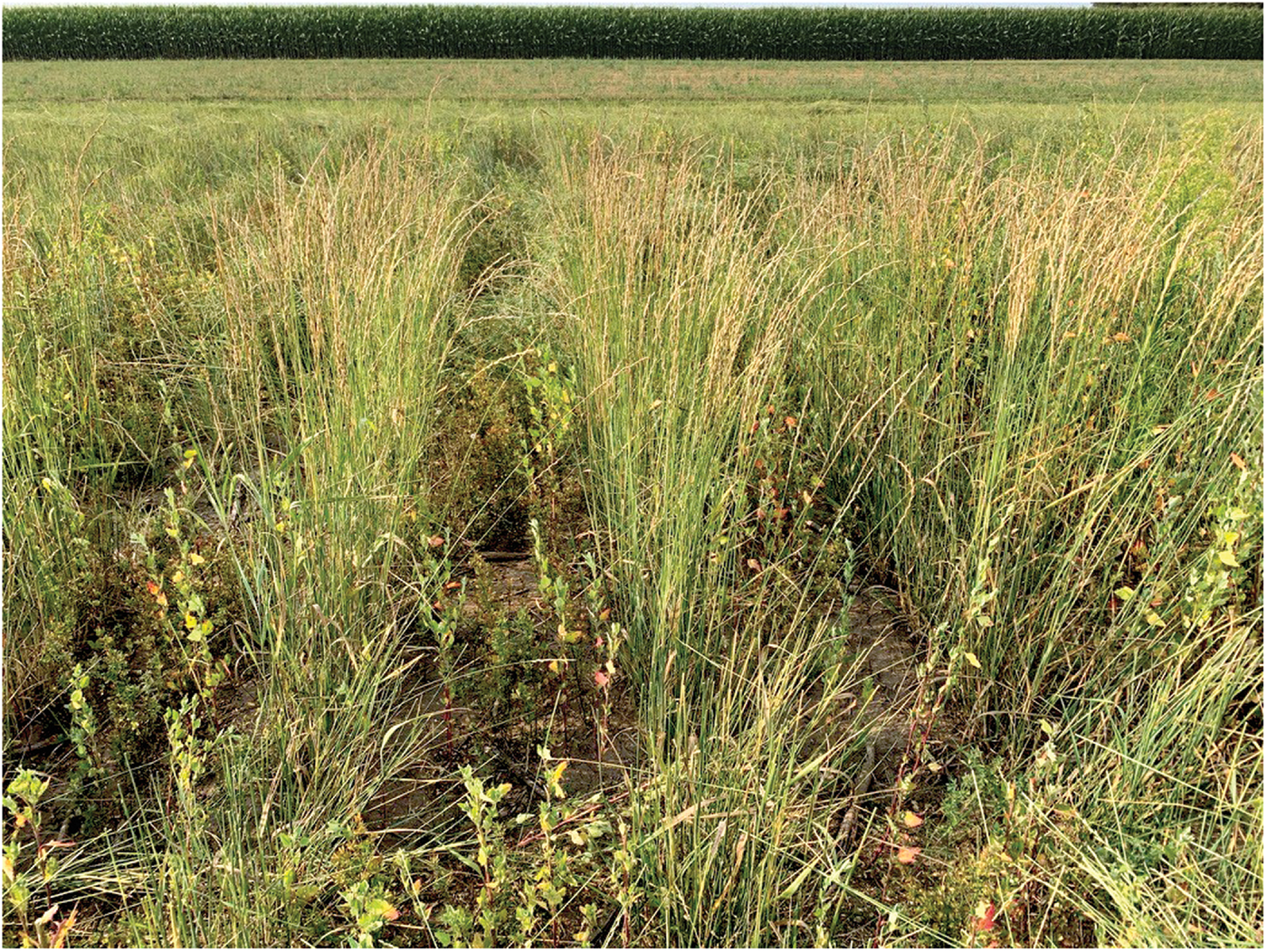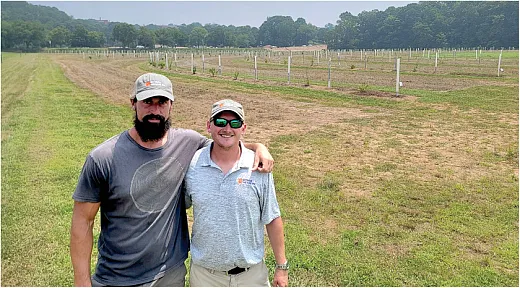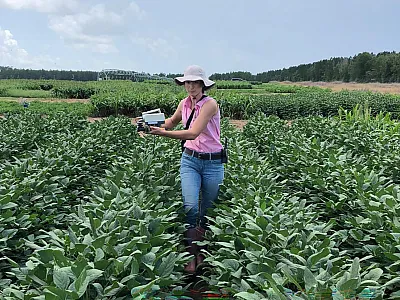Perennial Alternatives

Before row crop agriculture overtook much of the most fertile land across the United States, these lands were forests, prairies, and swamps. These native species were generally perennial (living more than two years); varying by location but growing together (polycultures) while occupying different ecological niches. Anyone who has gardened has observed that some years the tomatoes do better, other years it’s sweetcorn or green beans, but always there’s more okra and zucchini than almost anyone can eat. That resilience through diversity is one advantage of such systems, as we see now in agronomic intercropping and agroforestry, planting more than one species at a time in the same area.
It remains puzzling that of the estimated 2,300 plant species that have been “domesticated” by humans (Zeven & DeWet, 1982), we increasingly rely on just a few annual species, grown in monoculture with little genetic diversity, to provide most of our calories and nutrition. Much like other industrial commodities, these few commodity species are now relied on as raw edible ingredients of oils, starches, sugars, and proteins and then re‐combined with meats, vegetables, flours, and flavorings into products making up the bulk of modern American diets. As many of us work towards improving these commodity crops and systems, we know these annual monoculture crops are extremely productive given sufficient inputs. The tremendous 5‐ to 10‐fold yield gains make them the most economically and environmentally sustainable solution to feeding humanity, so far. These gains have provided food while freeing up land and labor for urbanization and recreation for a growing population.
Agronomic science, plant breeding, farmers, and industry avoiding the anticipated global food catastrophe is an absolute success story by any measure. Yet we as agricultural scientists will increasingly be tasked with addressing additional challenges in the future from climate change, input scarcity, and consolidation of farms. With the majority of consumers and policymakers further separated from agriculture, it’s important to periodically ask whether our current systems are the only or even the best systems to address future global needs. Furthermore, will our expertise be a part of developing future alternative food production systems or a barrier by limiting our focus to only those systems that have worked in the past?
In full disclosure, I discovered my calling of plant breeding in high school when my English teacher, Ms. Holmes, gave me Dr. Wes Jackson’s book Becoming Native to this Place. In this book, Dr. Jackson, founder of The Land Institute in Salina, KS (https://landinstitute.org/), hypothesizes perennial polyculture systems that mimic natural ecosystems may provide additional or alternative benefits to agriculture and food production. It is an attractive idea to both consumers and farmers that we could have ecosystems that are functionally productive, require less input and soil disturbance, and allow both us and other species to thrive on this planet. A major breeding and agronomic science investment would be needed, yet the opportunities and path to creating such systems are rarely if ever discussed by the mainstream agricultural scientists who have the most agency to develop them! Many in agriculture become interested when exposed to such ideas since every farmer and agriculturalist is by nature also an environmentalist. However, ideas of perennial polycultures have often been critically (and I think unfairly) attacked as being unfeasible and unrealistic.
New Landscape of Possibilities
Today both external challenges (climate change, water, and urbanization), new technologies (autonomous robots and AI), and consumer preferences (from those with the privilege of food security and choice of foods) create new landscapes of possibilities where novel agricultural systems may become economically feasible. Crop scientists, especially geneticists and breeders in partnership with other disciplines, are absolutely critical to create the varieties needed to make such systems a reality.
Crop scientists already routinely work on perennial grass species as forage and turf but not in developing proteins, starches, and oils used in the human diet. So consider that among the most profitable species on the landscape for growers, many are perennial human food crops. Citrus was king in Florida, the Rio Grande valley of Texas, and California. Pecan, walnut, almonds, and other nut crops are high‐protein, long‐lived profitable perennial crops. Pigeon pea has arguably been the only perennial grain food crop, until recently, with the successful development of perennial rice in China and the perennial intermediate wheatgrass by The Land Institute and partners as “Kernza” (Bajgain et al., 2020; Coyne, 2022). After decades of investment in breeding and development, perennial rice has shown to reduce farmer labor by 60% and inputs by nearly 50% with the same yields of annual rice (Zhang et al., 2023). The American Society of Agronomy has had a vibrant and growing community of researchers interested in perennial rice, Kernza, and other perennial grain crops such as perennials wheat, barley, sunflower, sorghum, and sainfoin. The Perennial Grains Community of ASA continues to grow, this year with 23 oral and poster abstracts planned for our Annual Meeting; in addition, we have an ASA/CSSA symposium on “Perennial Grains Development Around the World” with eight planned talks from all continents (see https://bit.ly/perennial‐grains).
In addition to the perennial grains approach, a broader immediate approach for perennializing agriculture involves diverse perennial circular systems, mainly forages in crop rotations, integration of livestock and crops, and grazing. The Resilience CAP, a $10 million NIFA SAS1 project, led by ASA and CSSA member Valentin Picasso, is working towards expanding perennials and diversity in agriculture. Yet existing forages and turf and new perennial grain crop systems should not be the only perennial cropping focus of our Society members’ research.
Incredible Potential to Meet Future Needs, Challenges
In mid‐July, the field tour of the National Association of Plant Breeders (NAPB) meeting at Clemson University, in South Carolina, visited one of the few university perennial polyculture demonstrations. Nearly 30 different tree and shrub species, mostly unique cultivars developed by independent and non‐professional breeders, were planted on berms and swales as crops and to help protect this bottomland from flooding during large rain events. Among these species were improved versions of U.S. native Black Walnut, Shagbark Hickory, Persimmon, Honey Locust, Paw Paw, Yaupon, American Beautyberry, and Blueberry; each carefully selected to occupy different ecosystem and agronomic niches. These berms were planted 55 ft apart to allow annual intercropping in between as these perennial species established. A number of questions were raised by the plant breeder attendees as to whether these systems “were for profit or for ecological restoration.” When the guides (Figure 1) said “both,” they were met with a surprising incredulous skepticism. It seems not all plant breeders like to think about the possibilities of what could be, despite being tasked with creating humanity’s future.

Agroforestry systems, traditionally outside the mainstream, have incredible potential to meet future needs and challenges of agriculture. Most of the species in this Clemson demonstration produce harvestable food products (nuts, fruit) or wood with small, but growing markets. These species and systems could help with goals for carbon, shading, improved water and nutrient management, wildlife habitat, and profit. Perhaps most importantly, we might expect these long‐lived perennial polyculture species to better buffer land from the effects of climate change. Increasingly, as our profession will be tasked not only with feeding the world, but also with these other global challenges, agricultural research on such systems deserve our attention.
Although we all grew up with annual monocultures producing the vast majority of our calories, with the new global challenges of climate change, carbon, land ownership, and labor, it is logical to continually rethink alternatives across the entire system. I hope that crop scientists, working with our colleagues in soils, agronomy, agricultural engineering, and food science, along with economists, social scientists, and local experts, think carefully about where to invest research to secure alternatives for long‐term future challenges as well as the steady marginal improvements to existing systems that have increased production historically. I specifically hope crop scientists can take the lead in creating and breeding such perennial alternatives for our global future.
References
Bajgain, P., Zhang, X., Jungers, J.M., DeHaan, L.R., Heim, B., Sheaffer, C. C., … & Anderson, J.A. (2020) ‘MN‐Clearwater’, the first food‐grade intermediate wheatgrass (Kernza perennial grain) cultivar. Journal of Plant Registrations, 14(3), 288–297. https://doi.org/10.1002/plr2.20042
Coyne, K. (2022) Research update: Kernza intermediate wheatgrass. CSA News magazine, 67(12), 3. https://doi.org/10.1002/csan.20905
Zhang, S., Huang, G., Zhang, Y., Lv, X., Wan, K., Liang, J., … & Hu, F. (2023) Sustained productivity and agronomic potential of perennial rice. Nature Sustainability, 6(1), 28–38.
Zeven, A.C., & De Wet, J.M. (1982) Dictionary of cultivated plants and their regions of diversity: excluding most ornamentals, forest trees and lower plants. Pudoc.
1NIFA SAS, National Institute of Food and Agriculture Sustainable Agricultural Systems.
Text © . The authors. CC BY-NC-ND 4.0. Except where otherwise noted, images are subject to copyright. Any reuse without express permission from the copyright owner is prohibited.











